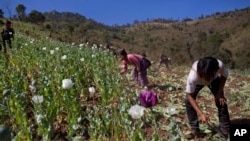The United Nations' latest report on opium production in Southeast Asia says cultivation remains concentrated in key regions of Myanmar (also known as Burma) and Laos, with little change in output in the past year.
The U.N. Office on Drugs and Crime's annual opium survey for Southeast Asia, released Monday, says over 760 metric tons of opium were produced largely in Myanmar as well as Laos in the past year, over 63,000 hectares.
The UNODC says although the region’s opium output changed little in the past year, there is ongoing demand, especially from opiate users in China.
Tens of thousands of often poor hill-tribe farmers remain dependent on income from opium poppy cultivation, living in isolated regions with few alternatives for work.
The border region of Myanmar, Laos and Thailand, is famously known as the “Golden Triangle,” the world's second largest area for opium production behind Afghanistan.
Jeremy Douglas, UNODC regional representative for Southeast Asia and Pacific, says that although output has stabilized, the long-term trend in recent years has been for a steady increase in production.
"We are reporting the eighth consecutive year for an increase in opium poppy cultivation in the Golden Triangle. This is highly concentrated in the Shan States and three times the production over the period of eight years in the region. In Laos we have three provinces where it is highly concentrated, Phongsali, Houaphan, and Xiangkhoang," says Douglas.
China tops user list
Most production in Myanmar lies in the northern Shan states close to the border with China, where ethnic groups rely on funds from opiates to support a long running insurgency. Authorities say vital chemicals, known as precursors, to break down the opium into heroin, are smuggled in from China and Vietnam.
Across Asia, the UNODC says there are currently over 3.3 million opiate users, largely concentrated in China - where registered users are estimated at 1.9 million, followed by Vietnam, Maynmar, Malaysia, Indonesia and Thailand.
The report says demand is in part linked to the resurgence in opium production in Southeast Asia in recent years. But a surge in use of amphetamine type stimulants has seen heroin use declining as a proportion of all registered drug users.
In Southeast Asia two thirds of opiates are sourced from Myanmar and Laos with the remainder from Afghanistan - the world's largest heroin producer.
UNODC's Douglas says although opiate production has steadied, the trade across the region, is worth up to $20 billion, representing a regional security threat especially as the 10-nation Association of South East Asian Nations (ASEAN) steps up regional economic integration.
"We have to look at this in perspective - it's like an undeclared ‘ASEAN state' that volume of money is just as powerful as some of the other states - in the hands of small groups and they have enormous power and they seem to be able to almost operate unimpeded for many years now."
The UNODC says moves to greater regional integration, improved roads and access infrastructure will likely benefit transnational criminal groups in the face of weak border controls in some regions. The group is calling for long term alternative development programs for opium poppy growers.





